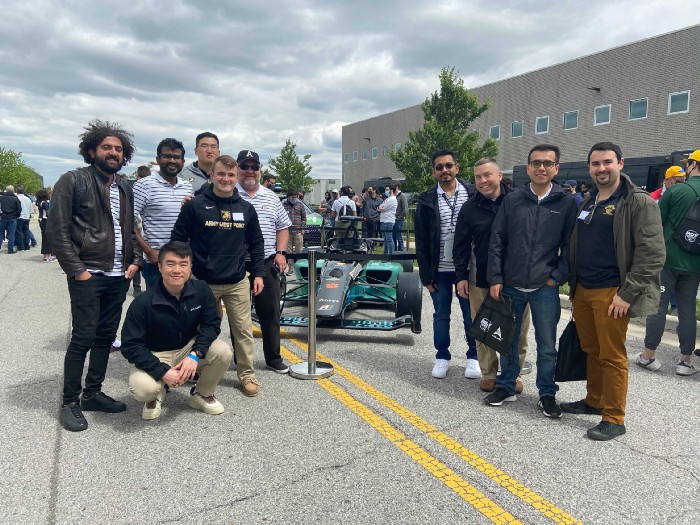Data takes the wheel at Indy — Drivers, start your algorithms!

After they drop the flag to start the race at the Indy Autonomous Challenge in October, the grand prize won’t go to the best driver but to the best-performing sensors, slickest algorithms, and fastest-thinking artificial intelligence (AI). Data science will determine the winner on the 2.5-mile oval at the famed Indianapolis Motor Speedway, when the race teams, all using the same Dallara-built AV-21 chassis, send out their driverless vehicles in search of victory.
In the first-of-its-kind race Oct. 21-23, Purdue is fielding one of those teams — Black & Gold Autonomous Racing — in collaboration with faculty and students from the U.S. Military Academy (USMA) at West Point. The competition kicked off in February 2020 with 30 teams from academic institutions around the world. Our B&G team has qualified for the final round after receiving excellent ratings for design documents and exceeding performance requirements, ranking in the top five teams in the last practice simulation race and first in the latest practice round.
We had the best first-lap time in the latest round, meaning our acceleration logic — from the starting position — outperformed that of all other competitors. This is crucial, because the objective is to develop an autonomous racing algorithm capable of carrying out the complex tasks needed to navigate a real-life track and surpass opponents — all while maintaining stability and meeting safety requirements at speeds reaching 200 mph.
The job involves overcoming challenging engineering problems — from sensor fusion to overtaking, collision avoidance, and path planning — with the aid of state-of-the-art machine learning algorithms. In particular, speeds of 200 mph have never been considered in the context of self-driving algorithms. Our participation puts us at the frontier of developing novel models for vehicle dynamics and control, as well as sensor data-acquisition algorithms that are suitable for these speeds and provide guidelines for optimal decision making.

In terms of sensor data acquisition, consider that at high speeds, the distance traveled between two consecutive camera snapshots could be 80 meters. We need to develop filtering algorithms to “make a guess” about what happened in those 80 meters, both to make immediate navigation decisions and to build a model for the environment that is useful in the long term. When making overtaking decisions, we need accurate short-term projections for the speeds of surrounding vehicles. We have to solve for the interconnections between very complex engineering tasks like high-speed data acquisition, environment modeling, and overtaking.
We are investigating deep learning algorithms for various tasks, including AI-based path planning and sensor fusion algorithms on top of traditional algorithms like the Proportional-Integral-Derivative (PID) controller and Model Predictive Control (MPC) that are common in industrial control systems. In the process, we are discovering important research insights that could help provide guideposts for data collection and learning optimization in high-speed navigation.
We are solving problems involving computer and mechanical engineering in a novel (autonomous and driverless) environment. For example, we’re tackling improvements to state-of-the-art tire and vehicle aerodynamic models to facilitate high-speed cornering, as well as exploiting the slipstream — drafting — for overtaking vehicles traveling at speeds very close to ours.
Transferring our simulation controller to the physical AV-21 car is challenging, and needs careful planning for safety measures. The first phase, currently underway, relies on bench testing and sensor calibration. We’re getting a helping hand from a professional racing team, RKM Racing. Robert Megennis, an accomplished Indy Lights race car driver, has been aiding us with data collection through a simulator, and advising on overtaking and trajectory planning decisions. His input will be particularly valuable with the physical race, as the simulated environment does not perfectly capture the aerodynamics.

Because autonomous racing requires solving a series of demanding engineering problems, it promises to have significant practical impact on the design of next-generation AI-based robotics systems that must endure tough environmental conditions, as well as possibly adversarial intelligent agents. AI-based autonomy is anticipated to be a central pillar for upcoming major economies and militaries, and being part of the Indy Autonomous Challenge gives us an excellent and timely opportunity to help shape that future.

For example, it is expected that AI-based autonomy will not only significantly affect transportation systems, but also accelerate growth and cost reduction in healthcare (e.g., involving medical devices and remote surgeries); the service industry (think restaurants and malls); and major infrastructure projects (such as buildings and bridges). It also will have important military applications, like AI for Small Unit Maneuver (AISUM) and autonomous weapon systems.
In turn, AI-based autonomy will free up our workforce, and open up job opportunities for tasks for which human intelligence is irreplaceable.
Source: Data takes the wheel at Indy — Drivers, start your algorithms!
